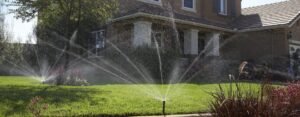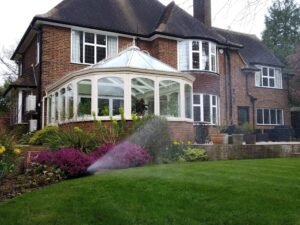Welcome To Our Irrigation Library!
Zones, programs and cycles



Irrigation zones refer to specific areas within a landscape that share similar water requirements. These zones are created to optimize water distribution and cater to the diverse needs of different plants, taking into account factors such as plant type, size, and local climate conditions.
From design side considering efficiency, a zone is a unit which use the maximum possible amount of flow provided by the water supply on a certain pressure and also includes identical type emitters.
Zones are groups of emitters connected together with pipework to irrigate same plants or plant groups on equal way by the same program at the same time. Zones can be grouped on different ways.
Similar Water Needs
Each irrigation zone consists of plants or areas with similar water requirements. For example, lawns, flower beds, trees, and shrubs may be grouped into separate zones based on their distinct needs for water.
Efficient Watering
Grouping plants with similar water needs into zones allows for more efficient watering. The irrigation system can be programmed to deliver the appropriate amount of water to each zone, avoiding overwatering or underwatering.
Customized Scheduling
Different zones may have varied watering schedules based on factors like sunlight exposure, soil type, and plant species. Customized scheduling ensures that each zone receives water at the optimal time and frequency.
Emitters and Water Distribution
The choice of emitters (such as sprinklers, drip lines, or bubblers) in each zone is tailored to the specific needs of the plants within that zone. This ensures precise water distribution, considering factors like coverage area and water flow.
System Flexibility
Irrigation zones provide flexibility in managing water resources. For instance, during dry periods, zones with drought-resistant plants may require less frequent watering compared to zones with more water-sensitive vegetation.
Zoning Criteria
The creation of irrigation zones involves considering factors such as plant type, soil conditions, sun exposure, and topography. Professional installers use these criteria to design an irrigation system that maximizes efficiency and promotes healthy plant growth.
Group of zones
By dividing the landscape into irrigation zones, gardeners and irrigation professionals can optimize water usage, minimize water wastage, and promote the overall health and vitality of plants. This zoning approach is a fundamental strategy in the design and management of effective automatic garden irrigation systems.
By irrigated plants
- lawn
- bed
- planter/pot
- tree
By emitters
- popup sprinklers
- micro sprinklers/field stands
- dripline
- planter/bubbler
Programs
Zones are organized into programs, running sequentially from the program’s start. Irrigation programs refer to predefined schedules or sequences that dictate when and how an irrigation system should operate.
These programs are essentially a set of instructions programmed into the irrigation controller, specifying when each zone or set of emitters should be activated and for how long. Irrigation programs are essential for optimizing water usage, ensuring proper plant hydration, and adapting to specific landscape needs.
Programs can be scheduled to run multiple times a day if needed. If different zones require varying start times for any reason, setting up additional programs provides the flexibility required. For instance, flower beds can be watered before nightfall, while the lawn is tended to at dawn.
Key components and concepts
- Start Times*: Programs include start times, indicating when the irrigation cycle begins. Multiple start times may be scheduled throughout the day, especially in hot climates or for areas with specific water requirements.
- Run Times: The run time specifies how long each zone will be watered during a particular irrigation cycle. This duration is based on factors such as plant needs, soil type, and weather conditions.
- Frequency*: The frequency determines how often the irrigation program repeats. It can be daily, every other day, multiple times a week, or according to a customized schedule.
- Seasonal Adjustments: Some advanced irrigation controllers allow for seasonal adjustments, automatically adapting the irrigation schedule based on changes in weather conditions or plant water requirements. As simple as it sounds: increasing the adjusmtent by 5% will increase each running time by 5%.
- Manual Overrides: Irrigation controllers usually have manual override options, allowing users to start or stop irrigation outside of the programmed schedule when necessary.
At most controllers, the frequency and the desirable start time will determine a program. Same program cannot be started on different zones at different time or different days.
Here’s a simple example of an irrigation program for a residential garden:
- Zone 1 (Lawn):
- Start Time: 6:00 AM
- Run Time: 15 minutes
- Frequency: Every other day
- Zone 2 (Flower Beds):
- Start Time: 7:30 AM
- Run Time: 20 minutes
- Frequency: Every day
These programs ensure that different areas of the landscape receive appropriate and tailored irrigation based on their unique needs.
